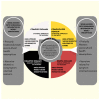Historical Osteopathic Principles and Practices in Contemporary Care: An Anthropological Perspective to Foster Evidence-Informed and Culturally Sensitive Patient-Centered Care: A Commentary
- PMID: 36611470
- PMCID: PMC9818574
- DOI: 10.3390/healthcare11010010
Historical Osteopathic Principles and Practices in Contemporary Care: An Anthropological Perspective to Foster Evidence-Informed and Culturally Sensitive Patient-Centered Care: A Commentary
Abstract
Historical osteopathic principles and practices (OPP)-considering the patient as a dynamic interaction of the body, mind, and spirit and incorporating the body's self-healing ability into care-are inherited from traditional/complementary and alternative (CAM) principles. Both concepts are familiar to contemporary osteopathic practitioners, but their incorporation into healthcare for evidence-informed, patient-centered care (PCC) remains unclear. Further, a polarity exists in the osteopathic profession between a 'traditional-minded' group following historical OPP despite evidence against those models and an 'evidence-minded' group following the current available evidence for common patient complaints. By shifting professional practices towards evidence-based practices for manual therapy in line with the Western dominant biomedical paradigm, the latter group is challenging the osteopathic professional identity. To alleviate this polarity, we would like to refocus on patient values and expectations, highlighting cultural diversity from an anthropological perspective. Increasing an awareness of diverse sociocultural health assumptions may foster culturally sensitive PCC, especially when including non-Western sociocultural belief systems of health into that person-centered care. Therefore, the current medical anthropological perspective on the legacy of traditional/CAM principles in historical OPP is offered to advance the osteopathic profession by promoting ethical, culturally sensitive, and evidence-informed PCC in a Western secular environment. Such inclusive approaches are likely to meet patients' values and expectations, whether informed by Western or non-Western sociocultural beliefs, and improve their satisfaction and clinical outcomes.
Keywords: Western healthcare; anthropology; complementary therapies; culturally sensitive care; health belief model; historical osteopathic practices; historical osteopathic principles; manipulation; medical; medicine; osteopathic; patient-centered care; traditional.
Conflict of interest statement
R.Z.-P., F.B., and C.L. report a competing interest because they are providing continuing professional development courses on the clinical relevance of historical osteopathic principles and practices in contemporary care. D.D. declares no conflict of interest. The funder had no role in the design or writing of the manuscript.
Figures
Similar articles
-
Indigenous Epistemological Frameworks and Evidence-Informed Approaches to Consciousness and Body Representations in Osteopathic Care: A Call for Academic Engagement.Healthcare (Basel). 2025 Mar 7;13(6):586. doi: 10.3390/healthcare13060586. Healthcare (Basel). 2025. PMID: 40150436 Free PMC article.
-
Patient-Practitioner-Environment Synchronization: Four-Step Process for Integrating Interprofessional and Distinctive Competencies in Osteopathic Practice-A Scoping Review with Integrative Hypothesis.Healthcare (Basel). 2025 Apr 4;13(7):820. doi: 10.3390/healthcare13070820. Healthcare (Basel). 2025. PMID: 40218117 Free PMC article. Review.
-
Epistemological Flexibility in Person-Centered Care: The Cynefin Framework for (Re)Integrating Indigenous Body Representations in Manual Therapy.Healthcare (Basel). 2024 Jun 5;12(11):1149. doi: 10.3390/healthcare12111149. Healthcare (Basel). 2024. PMID: 38891224 Free PMC article.
-
The experiences of persons living with HIV who participate in mind-body and energy therapies: a systematic review protocol of qualitative evidence.JBI Database System Rev Implement Rep. 2015 Oct;13(10):41-9. doi: 10.11124/jbisrir-2015-2321. JBI Database System Rev Implement Rep. 2015. PMID: 26571281
-
Integrating Osteopathic Principles for Enhanced Dermatological Outcomes: A Literature Review.Cureus. 2024 Jan 21;16(1):e52665. doi: 10.7759/cureus.52665. eCollection 2024 Jan. Cureus. 2024. PMID: 38260105 Free PMC article. Review.
Cited by
-
Indigenous Epistemological Frameworks and Evidence-Informed Approaches to Consciousness and Body Representations in Osteopathic Care: A Call for Academic Engagement.Healthcare (Basel). 2025 Mar 7;13(6):586. doi: 10.3390/healthcare13060586. Healthcare (Basel). 2025. PMID: 40150436 Free PMC article.
-
Patient-Practitioner-Environment Synchronization: Four-Step Process for Integrating Interprofessional and Distinctive Competencies in Osteopathic Practice-A Scoping Review with Integrative Hypothesis.Healthcare (Basel). 2025 Apr 4;13(7):820. doi: 10.3390/healthcare13070820. Healthcare (Basel). 2025. PMID: 40218117 Free PMC article. Review.
-
Epistemological Flexibility in Person-Centered Care: The Cynefin Framework for (Re)Integrating Indigenous Body Representations in Manual Therapy.Healthcare (Basel). 2024 Jun 5;12(11):1149. doi: 10.3390/healthcare12111149. Healthcare (Basel). 2024. PMID: 38891224 Free PMC article.
-
The Revisions of the First Autobiography of AT Still, the Founder of Osteopathy, as a Step towards Integration in the American Healthcare System: A Comparative and Historiographic Review.Healthcare (Basel). 2024 Jan 6;12(2):130. doi: 10.3390/healthcare12020130. Healthcare (Basel). 2024. PMID: 38255019 Free PMC article. Review.
-
Reconceptualizing Somatic Dysfunction in the Light of a Neuroaesthetic Enactive Paradigm.Healthcare (Basel). 2023 Feb 7;11(4):479. doi: 10.3390/healthcare11040479. Healthcare (Basel). 2023. PMID: 36833014 Free PMC article.
References
-
- Zegarra-Parodi R., Draper-Rodi J., Haxton J., Cerritelli F. The Native American Heritage of the Body-Mind-Spirit Paradigm in Osteopathic Principles and Practices. Int. J. Osteopath. Med. 2019;33:31–37. doi: 10.1016/j.ijosm.2019.10.007. - DOI
-
- Stark J.E. An Historical Perspective on Principles of Osteopathy. Int. J. Osteopath. Med. 2013;16:3–10. doi: 10.1016/j.ijosm.2012.10.001. - DOI
-
- Ordre des Masseurs-Kinésithérapeutes Guide D’information Et De Prévention Contre Les Dérives Thérapeutiques. [(accessed on 22 September 2022)]. Available online: https://www.ordremk.fr/actualites/kines/le-conseil-national-publie-un-gu...
Grants and funding
LinkOut - more resources
Full Text Sources



